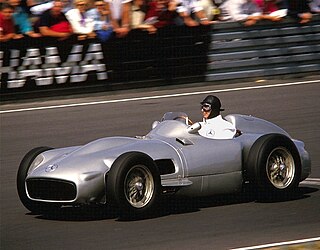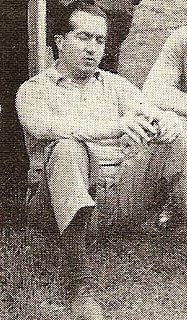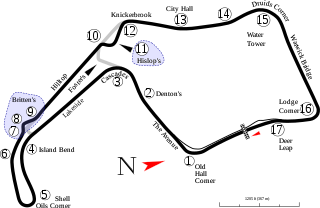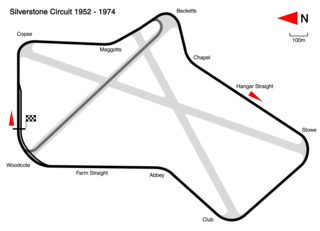
The Albert Park Circuit is a motorsport street circuit around Albert Park Lake, three kilometres south of central Melbourne. It is used annually as a circuit for the traditional Formula One season-opening Australian Grand Prix, the supporting Supercars Championship Melbourne 400 and other associated support races. The circuit has an FIA Grade 1 license.

John Michael Hawthorn was a British racing driver. He became the United Kingdom's first Formula One World Champion driver in 1958, whereupon he announced his retirement, having been profoundly affected by the death of his teammate and friend Peter Collins two months earlier in the 1958 German Grand Prix. Hawthorn also won the 1955 24 Hours of Le Mans, but was haunted by his involvement in the disastrous crash that marred the race. Hawthorn died in a road accident three months after retiring.

Sir Stirling Craufurd Moss was a British Formula One racing driver. An inductee into the International Motorsports Hall of Fame, he won 212 of the 529 races he entered across several categories of competition and has been described as "the greatest driver never to win the World Championship". In a seven-year span between 1955 and 1961 Moss finished as championship runner-up four times and in third place the other three times.

Silverstone Circuit is a motor racing circuit in England, near the Northamptonshire villages of Silverstone and Whittlebury. It is the current home of the British Grand Prix, which it first hosted as the 1948 British Grand Prix. The 1950 British Grand Prix at Silverstone was the first race in the newly created World Championship of Drivers. The race rotated between Silverstone, Aintree and Brands Hatch from 1955 to 1986, but settled permanently at the Silverstone track in 1987. The circuit also hosts the British round of the MotoGP series.

The 1957 Argentine Grand Prix was a Formula One motor race held on 13 January 1957 at the Buenos Aires circuit. It was race 1 of 8 in the 1957 World Championship of Drivers.

The 1957 Formula One season was the 11th season of FIA Formula One motor racing. It featured the 1957 World Championship of Drivers which commenced on 13 January 1957 and ended on 8 September after eight races. Juan Manuel Fangio won his fourth consecutive title, his fifth in total, in his final championship. A feat that would not be beaten until Michael Schumacher in 2003. The season also included numerous non-championship races for Formula One cars.

The 1956 Formula One season was the tenth season of FIA's Formula One motor racing. It featured the seventh World Championship of Drivers as well as numerous non-championship races. The championship series commenced on 22 January 1956 and ended on 2 September after eight races. Juan Manuel Fangio won his third consecutive title, the fourth of his career. Until the 2006 season, this was the last season during which no British constructor won any championship race.

The 1955 Formula One season was the ninth season of FIA Formula One motor racing. It featured the 1955 World Championship of Drivers, which commenced on 16 January 1955 and ended on September 11 after seven races. Juan Manuel Fangio won his second consecutive World Championship title in a season that was curtailed by tragedies.

The 1952 Formula One season was the sixth season of FIA Formula One motor racing. In comparison to previous seasons, the 1952 season consisted of a relatively small number of Formula One races, following the decision to run all the Grand Prix events counting towards the World Championship of Drivers to Formula Two regulations rather than Formula One. The Indianapolis 500, which also counted towards the World Championship, was still run to AAA regulations as in previous seasons.

Peter John Collins was a British racing driver. He was killed in the 1958 German Grand Prix, just weeks after winning the RAC British Grand Prix. He started his career as a 17-year-old in 1949, impressing in Formula 3 races, finishing third in the 1951 Autosport National Formula 3 Championship.

JBW Cars was a British racing car manufacturer in the late 1950s, who were a Formula One constructor from 1959 to 1961.

Reginald Parnell was a racing driver and team manager from Derby, England. He participated in seven Formula One World Championship Grands Prix, achieving one podium, and scoring a total of nine championship points.
The 1934 Grand Prix season saw the advent of the new 750kg Formula. In an effort to curb the danger of rising speeds, the AIACR imposed this upper weight limit that effectively outlawed the large capacity engines. The incumbent manufacturers Alfa Romeo, Maserati and Bugatti had been preparing their new models with varying success – the best of which was the Alfa Romeo Tipo B. However, it was the state-sponsored arrival of the two German teams, Mercedes-Benz and Auto Union, and their innovative and progressive cars that ignited a new, exciting era of motor racing.
The 3rd Cornwall MRC Formula 1 Race was a motor race, run to Formula One rules, held on 30 May 1955 at the Davidstow Circuit, Cornwall. The race was run over 20 laps of the little circuit, and was won by British driver Leslie Marr in a Connaught Type B.

The 1955 RAC Tourist Trophy took place on 17 September, on the roads around Dundrod,. It was also the fifth round of the F.I.A. World Sports Car Championship, however it was the first championship race following the horrendous tragedy at Le Mans. It was also the Golden Jubilee year for the Tourist Trophy. Going into the race, Ferrari were leading the Manufacturers Championship by four points from Jaguar. Victory for the Italian marque would put them in a strong position to win a third successive title.

The 2nd International Gold Cup was a motor race, run to Formula One rules, held on 24 September 1955 at the Oulton Park Circuit, Cheshire. The race was run over 54 laps of the circuit, and was won by British driver Stirling Moss in a Maserati 250F.
The 1st International Gold Cup was a motor race, run to Formula One rules, held on 7 August 1954 at the Oulton Park Circuit, Cheshire. The race was run over 36 laps of the circuit, and was won by British driver Stirling Moss in a Maserati 250F.

The 3rd BRDC International Trophy meeting was held on 5 May 1951 at the Silverstone Circuit, England. The race was run to Formula One regulations, and was held over two heats of 15 laps each, followed by a final race of 35 scheduled laps. However, the race was stopped after just six laps due to torrential rain and flooding. British driver Reg Parnell, driving a Ferrari 375, was declared the winner.

The 6th BRDC International Trophy meeting was held on 15 May 1954 at the Silverstone Circuit, Northamptonshire. The race was run to Formula One regulations, and was held over two heats of 15 laps each, followed by a final race of 35 laps. Argentinian driver José Froilán González, driving a Ferrari 625, set fastest qualifying lap, won his qualifying heat and the final, and also set fastest lap.
The 1951 Paris Grand Prix was a Non-Championship Formula One motor race held on 20 May 1951 at the Bois de Boulogne, in Paris, France. It was the last motor race to take place at the circuit, due to concerns over driver and spectator safety.
















